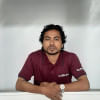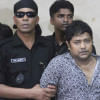Six Years of Rana Plaza Tragedy: Survivors still in trauma

Nilufar Begum, 35, a survivor of Rana Plaza tragedy, worked on the fifth floor of the building. Her right leg was severely injured in the incident. Six years have passed since the building collapsed, but she is still living in trauma.
She received long term treatment at several hospitals of the country, but says her health has not improved. "Not only was my right leg broken, I also sustained injuries in my head and back. The pain still hasn't receded," she said, adding that she was stuck for nine hours before being rescued.
Nilufar received Tk 3 lakh from several organisations after the tragedy, which was spent on initial treatment. "I am barely surviving now," she said, "Doctors have advised me to amputate my right leg. They said it will ease my suffering but I am already spending over Tk 5,000 on medicine every month. I have sold all of my property, including my house, for medical treatment."

Nilufar cannot work outside anymore, and requires assistance for all types of movement.
Many survivors of Rana Plaza tragedy are living in despair. This correspondent spoke to ten survivors, all of whom echoed Nilufar's sentiments.
Nilufa Yasmin, 40, another survivor who worked on the fourth floor of the building, said, "I was rescued after two days. My head, legs, and backbone were heavily injured. Despite treatment at different hospitals with aid from several organisations, I am still suffering from chronic back pain and headache."
"I don't know how to support my six-member family. My husband is a rickshaw-puller and sole earning member. It is difficult for us to bear my treatment cost. Moreover, I have two school-going daughters," she said, adding that it would be helpful if the government arranged financial aid for survivors.
Victim families DEMAND capital punishment
Talking to The Daily Star, Rahela Khatun, 70, mother of Fozle Rabbi, who lost his life in the accident, said, "I lost my son but I am unsure if I will ever get justice."
Abdul Aziz, 65, who lost his son and daughter-in-law in the tragedy, now runs a tea stall at Savar's Arapara area. "If my son was alive, he would look after me. But he is no more, and justice has not been served," he said, "I would find peace of mind if the accused was handed capital punishment."
Khairul Mamun Mintu, organising secretary of Garment Worker Trade Union Centre, said the government should take steps to ensure quick trial and appropriate punishment for culprits. "The authorities concerned should also arrange lifetime treatment for injured survivors," he added.
Rana Plaza collapse was the deadliest garments factory accident in Bangladesh's history, in which 1,129 workers lost their lives and thousands were injured.

 For all latest news, follow The Daily Star's Google News channel.
For all latest news, follow The Daily Star's Google News channel. 








Comments